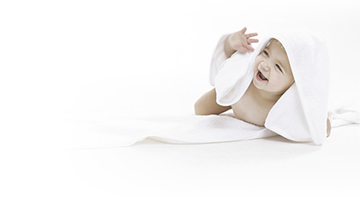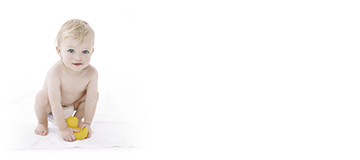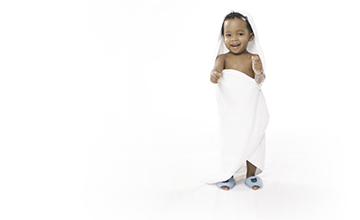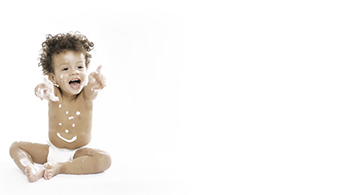
CHILDREN'S SKIN
In babies and children the ratio of skin surface area to body volume is significantly larger than in adults.
Babies skin needs particularly careful protection, because it doesn’t yet have the natural acid mantle, which has a pH value of 5.5.
Baby sebamed was developed specifically for the needs of sensitive children’s skin and dermatologically tested for compatibility. Its pH value of 5.5 plays a particularly important role in children’s early years, because it promotes the formation of the acid mantle. Baby sebamed can be used in conjunction with a course of treatment for neurodermatitis, eczemas, skin infections, and other types of irritation, but you should confirm this with your child’s paediatrician beforehand. The cleansing products in the range start to protect and nourish the skin as soon as you begin washing with them, while the care products calm irritated skin, support the healing process and help to protect the delicate skin found in children.
The special characteristics of babies’ skin
- In babies the ratio of skin surface area
to body volume is significantly larger than in adults. - The dermis is thinner than in adults.
- The water content of the horny layer
is higher, and its structure is looser. - The skin hardly produces any sebum before puberty.
- Sweat is not able to regulate a baby’s body temperature
as effectively as it does in adults. - The acid mantle only begins to develop after a
baby has been born and is liable to break down
during childhood.
Why daily care is so important to your child
During the first few months of its life, your baby’s need for loving physical contact is especially strong. Bathing them and providing them with daily care offers you an ideal opportunity to shower them with affection. Speak tenderly to them and cuddle them frequently when changing their nappy. Impulses are sent to the nervous system and the brain via the skin, so by doing this, you will be aiding both the physical and the mental development of your child.
How does the delicate skin of babies differ from that of adults?
Baby skin is not yet as resistant as adult skin. It can be up to ten times thinner and is damaged more easily. Baby skin does not yet have the natural acid mantle either, which has yet to develop and which has a pH value of 5.5. You should therefore only use special baby care products which are compatible with the delicate skin of your youngster. Make sure you choose products that don’t remove too much oil from the skin and that support the formation of the acid mantle.
Babies’ skin doesn’t yet have the natural acid mantle, which has a pH value of 5.5.
The acid mantle protects the skin from irritants, allergens, pathogens, and from drying out, and its pH value plays a particularly important role in children’s early years. Dermatologists therefore recommend selecting cleansing and care products that match the skin’s natural pH value of 5.5.
The development of the acid mantle and health skin flora
- A baby’s skin is normally sterile at birth.
- In the first few weeks of their life, the build-up of metabolites in the skin cells, the development of skin flora, and the establishment of regulation mechanisms in the skin, lower its initial pH value of 6.5 to 5.5.
- Through physical contact with other people, the baby’s skin is “vaccinated” with microorganisms.
- The defence of the acid mantle against harmful microorganisms on the skin is not yet working sufficiently during the first few months.
Baby sebamed - protective baby care from the very beginning
Baby sebamed was developed in cooperation with skin and paediatric clinics for the specific needs of babies’ skin and dermatologically tested for compatibility. We assure you that by using sebamed for babies and young children from the very beginning, you will be doing the best thing you could possibly do for your child’s skin. High-quality, effective ingredients and the pH value of 5.5 will ensure that the sensitive skin remains healthy, and if your child suffers from irritation or sore areas, Baby sebamed will calm the skin and accelerate the healing process. The pH value will also promote the formation of the natural acid mantle, which is essential for the health of delicate baby skin.
Checklist for cleansing and caring for babies’ and children’s skin
Bathing
- Should not occur before your child’s navel has healed.
- Should occur at a maximum of three times a week if your
child has healthy skin. Should not take place more than once
a week if your child has dry skin. Bath babies at a temperature
between 32°C and 37°C. Babies should not be in the bath for
longer than ten minutes, and older children should be out
within 20 minutes. - Use bubble baths sparingly (no foam mountains), and rinse
your child’s skin thoroughly with plain water at the end. - Allow their skin to air-dry after oil baths.
Showers
- Should occur at a maximum of three times a week (and not on bath days) if your child has healthy skin. You can start giving your child a shower from about the age of two.
- Should only take place once or twice a week if your child has dry skin. They should be no longer than five minutes in this case, and the temperature should be between 32°C and 35°C.
- Use shower products sparingly and rinse them off thoroughly.
Hair
- Should take place in the bath or in the shower if possible. Once a week is often enough.
- Use shampoos sparingly and only apply them once. Do not leave them on for too long before rinsing your child’s hair thoroughly.
- Avoid contact with eyes.
Cleansing the nappy area
- Change your child’s nappy six or seven times a day, more often if necessary.
- Do not put used nappies on again, even if they appear to be clean.
- Even if there appears to be no faeces or urine on your child’s skin, wipe their bottom from their pubic bone to their buttocks using a wet cellulose cloth, a wet wipe, or a wet oiled cloth (tap water is sufficient here). Always wipe from front to back.
- Wipe off more stubborn dirt using wet wipes or oiled cloths and without rubbing too hard. Dried on faeces can be softened with a wet cellulose cloth or oiled cloth to make it easier to remove. Only put a clean nappy on once your child’s bottom is dry.
- If their bottom tends to get sore, apply a rash cream to the skin once it is clean and dry.
Putting cream on
- Apply a cream to normal, healthy skin after every bath, shower, splash about session, and visit to the swimming pool.
- Put cream on dry spot at least once a day.
- Only use greasy creams as protection from the cold (when the temperature outside is below 7°C) or if your child has very dry skin.
- Do not spread creams and lotions on too thickly. Just apply the amount the skin can absorb.
Sun protection
- Children less than 12 months old should not be exposed to the sun.
- Older children should have as much skin as possible covered by clothing.
- Apply sun lotion to any exposed skin at least every two hours.
- Also apply sun lotion to any skin covered by thin, light-coloured clothing.
- Choose a lotion with a protection factor of at least 20 and put it on even if your child’s skin is tanned or the weather is overcast.



